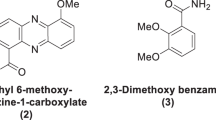Abstract
Alphaproteobacterium strain Q-1 produces an extracellular multicopper oxidase (IOX), which catalyzes iodide (I–) oxidation to form molecular iodine (I2). In this study, the antimicrobial activity of the IOX/iodide system was determined. Both Gram-positive and Gram-negative bacteria tested were killed completely within 5 min by 50 mU mL–1 of IOX and 10 mM iodide. The sporicidal activity of the system was also tested and compared with a common iodophor, povidone-iodine (PVP-I). IOX (300 mU mL–1) killed Bacillus cereus, B. subtilis, and Geobacillus stearothermophilus spores with decimal reduction times of 2.58, 7.62, and 40.9 min, respectively. However, 0.1 % PVP-I killed these spores with much longer decimal reduction times of 5.46, 38.0, and 260 min, respectively. To evaluate the more superior sporicidal activity of the IOX system over PVP-I, the amount of free iodine (non-complexed I2) was determined by an equilibrium dialysis technique. The IOX system included more than 40 mg L–1 of free iodine, while PVP-I included at most 25 mg L–1 free iodine. Our results suggest that the new enzyme-based antimicrobial system is effective against a wide variety of microorganisms and bacterial spores, and that its strong biocidal activity is due to its high free iodine content, which is probably maintained by re-oxidation of iodide released after oxidation of cell components by I2.




Similar content being viewed by others
References
Amachi S, Muramatsu Y, Akiyama Y, Miyazaki K, Yoshiki S, Hanada S, Kamagata Y, Ban-nai T, Shinoyama H, Fujii T (2005) Isolation of iodide-oxidizing bacteria from iodide-rich natural gas brines and seawaters. Microb Ecol 49:547–557
Atemnkeng MA, Plaizier-Vercammen J, Schuermans A (2006) Comparison of free and bound iodine and iodide species as a function of the dilution of three commercial povidone-iodine formulations and their microbiocidal activity. Int J Pharm 317:161–166
Cooper RA (2007) Iodine revisited. Int Wound J 4:124–137
Ehara A, Suzuki H, Kanesaki Y, Yoshikawa H, Amachi S (2014) Draft genome sequence of strain Q-1, an iodide-oxidizing Alphaproteobacterium isolated from natural gas brine water. Genome Announc 2:e00659–14
Fuglsang CC, Johansen C, Christgau S, Adler-Nissen J (1995) Antimicrobial enzymes: application and future potential in the food industry. Trends Food Sci Technol 6:390–396
Gottardi W (1983) Chapter 8: iodine and iodine compounds. In: Block SS (ed) Disinfection, sterilization and preservation, 3rd edn. Lea & Febiger, Philadelphia, pp 183–196
Hansen EH, Albertsen L, Schäfer T, Johansen C, Frisvad JC, Molin S, Gram L (2003) Curvularia haloperoxidase: antimicrobial activity and potential application as a surface disinfectant. Appl Environ Microbiol 69:4611–4617
Hickey J, Panicucci R, Duan Y, Dinehart K, Murphy J, Kessler J, Gottardi W (1997) Control of the amount of free molecular iodine in iodine germicides. J Pharm Pharmacol 49:1195–1199
Muramatsu Y, Fehn U, Yoshida S (2001) Recycling of iodine in fore-arc areas: evidence from the iodine brines in Chiba, Japan. Earth Planet Sci Lett 192:583–593
Sakuma A (2005) Manufacturing, recovery and recycling of iodine. In: Yokoyama M (ed) Function & application of iodine compounds. CMC Publishing, Tokyo, pp 15–27 (in Japanese)
Suzuki M, Eda Y, Ohsawa S, Kanesaki Y, Yoshikawa H, Tanaka K, Muramatsu Y, Yoshikawa J, Sato I, Fujii T, Amachi S (2012) Iodide oxidation by a novel multicopper oxidase from Alphaproteobacterium strain Q-1. Appl Environ Microbiol 78:3941–3949
Takikawa K, Nakano M, Arita T (1978) Change in apparent permeability of iodine in the presence of polyvinylpyrrolidone. Chem Pharm Bull 26:874–879
Funding
This work was partially supported by grants from the Japan Foundation for Applied Enzymology, JSPS KAKENHI (20780049), and the Institute of Fermentation, Osaka, Japan, to S. A.
Conflict of interest
The authors confirm that they have no conflict of interests.
Ethical approval
This article does not contain any studies with human participants or animals performed by any of the authors.
Author information
Authors and Affiliations
Corresponding author
Electronic supplementary material
Below is the link to the electronic supplementary material.
ESM 1
(PDF 172 kb)
Rights and permissions
About this article
Cite this article
Yuliana, T., Ebihara, K., Suzuki, M. et al. A novel enzyme-based antimicrobial system comprising iodide and a multicopper oxidase isolated from Alphaproteobacterium strain Q-1. Appl Microbiol Biotechnol 99, 10011–10018 (2015). https://doi.org/10.1007/s00253-015-6862-0
Received:
Revised:
Accepted:
Published:
Issue Date:
DOI: https://doi.org/10.1007/s00253-015-6862-0




